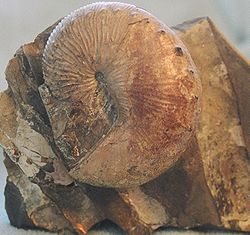Paleocene ammonites
 From Wikipedia - Reading time: 5 min
From Wikipedia - Reading time: 5 min

The term Paleocene ammonites describes families or genera of Ammonoidea that may have survived the Cretaceous–Paleogene extinction event, which occurred 66.043 million years ago. Although almost all evidence indicated that ammonites did not survive past the K–Pg boundary, there is some scattered evidence that some ammonites lived for a short period of time during the Paleocene epoch, although none survived the Danian (66-61 Ma);[1] they were likely extinct within 500,000 years of the K-Pg extinction event, which correlates to roughly 65.5 Ma.[1][2][3][4][5] The evidence for Paleocene ammonoids is rare and remains controversial.
Implications
[edit]There have been reliable reports of ammonite fossils from the early Paleocene. The most notable fossil finds of Paleocene ammonoids are Baculites vertebralis and Hoploscaphites constrictus in Denmark, the survivors joined by Eubaculites carinatus in the Netherlands.[1][2][3][4][5]
Discoscaphites and Eubaculites (potentially along with other ammonite genera, such as Pachydiscus and Sphenodiscus) have reportedly been found in the Paleocene Hornerstown and Tinton Formations in New Jersey (dating to 66-65 Ma).[3][6] However, there are questions whether some remains are not reworked from Maastrichtian layers.[1][7] A single scaphitiid mould (tentatively referred to Hoploscaphites) was dated to the lower Danian, in the Sumbar River section of the western Kopet Dagh in Turkmenistan.[8][9] Scattered remains of Eubaculites which were found near the Brazos River, Texas, were dubiously dated to the Danian.[10]
List of purported Paleogene ammonite fossils
[edit]- Cerithium Limestone, Denmark: Baculites vertebralis, Hoploscaphites constrictus[1][2][3][8][9]
- Maastricht Formation (Meerssen Member unit IVf-7), Netherlands: Baculites vertebralis, Eubaculites carinatus, Hoploscaphites constrictus[1][4]
- Tinton Formation and Hornerstown Formation, New Jersey: Discoscaphites, Eubaculites and possibly also Pachydiscus and Sphenodiscus[1][3][6][7]
- ?Sumbar River, Turkmenistan? :"Hoploscaphites constrictus johnjagti"[1][8]
- ?Brazos River K-T Boundary, Texas?: Eubaculites fragments[10]
References
[edit]- ^ a b c d e f g h Landman, Neil H.; Goolaerts, Stijn; Jagt, John W.M.; Jagt-Yazykova, Elena A.; Machalski, Marcin (2015), Klug, Christian; Korn, Dieter; De Baets, Kenneth; Kruta, Isabelle (eds.), "Ammonites on the Brink of Extinction: Diversity, Abundance, and Ecology of the Order Ammonoidea at the Cretaceous/Paleogene (K/Pg) Boundary", Ammonoid Paleobiology: From macroevolution to paleogeography, Topics in Geobiology, vol. 44, Dordrecht: Springer Netherlands, pp. 497–553, doi:10.1007/978-94-017-9633-0_19, ISBN 978-94-017-9632-3, retrieved 2021-10-26
- ^ a b c Machalski, Marcin; Heinberg, Claus (2005-12-01). "Evidence for ammonite survival into the Danian (Paleogene) from the Cerithium Limestone at Stevns Klint, Denmark". Bulletin of the Geological Society of Denmark. 52: 2005–12. doi:10.37570/bgsd-2005-52-08.
- ^ a b c d e Machalski, M.; Jagt, J. W. M.; Heinberg, C.; Landman, N. H.; Hakansson, E. (2009). "Dańskie amonity - obecny stan wiedzy i perspektywy badań". Przegląd Geologiczny (in Polish). 57 (6): 486–493. ISSN 0033-2151.
- ^ a b c W. M. Jagt, John (2012-01-01). "Ammonieten uit het Laat-Krijt en Vroeg-Paleogeen van Limburg". Grondboor & Hamer. 66 (1): 154–183.
- ^ a b "Late Maastrichtian and earliest Danian scaphitid ammonites from central Europe: Taxonomy, evolution, and extinction - Acta Palaeontologica Polonica". www.app.pan.pl. Retrieved 2021-10-26.
- ^ a b Neil H. Landman, Matthew P. Garb, Remy Rovelli, Denton S. Ebel, and Lucy E. Edwards "Short-Term Survival of Ammonites in New Jersey After the End-Cretaceous Bolide Impact," Acta Palaeontologica Polonica 57(4), 703-715, (1 December 2012). https://doi.org/10.4202/app.2011.0068
- ^ a b Gallagher, W.B. (2005). "Recent mosasaur discoveries from New Jersey and Delaware, USA: stratigraphy, taphonomy and implications for mosasaur extinction." Netherlands Journal of Geosciences — Geologie en Mijnbouw, 84(3): 241-245. [1] Archived 2012-09-04 at the Wayback Machine
- ^ a b c Machalski, Marcin; Jagt, John W. M.; Alekseev, Alexander S.; Jagt-Yazykova, Elena A. (December 2012). "Terminal Maastrichtian Ammonites from Turkmenistan, Central Asia". Acta Palaeontologica Polonica. 57 (4): 729–735. doi:10.4202/app.2011.0110. ISSN 0567-7920. S2CID 55940319.
- ^ a b Staaf, Danna (2017). Squid Empire: The Rise and Fall of the Cephalopods. University Press of New England. ISBN 978-1-61168-923-5. Archived from the original on September 23, 2017.
- ^ a b Witts, James D.; Landman, Neil H.; Garb, Matthew P.; Irizarry, Kayla M.; Larina, Ekaterina; Thibault, Nicolas; Razmjooei, Mohammed J.; Yancey, Thomas E.; Myers, Corinne E. (2021-01-13). "Cephalopods from the Cretaceous-Paleogene (K-Pg) boundary interval on the Brazos River, Texas, and extinction of the ammonites (American Museum novitates, no. 3964)". American Museum Novitates. doi:10.1206/3964.1. hdl:2246/7250. ISSN 0003-0082. S2CID 231597207.
 KSF
KSF